Punch Brothers: The Undiscovered Country
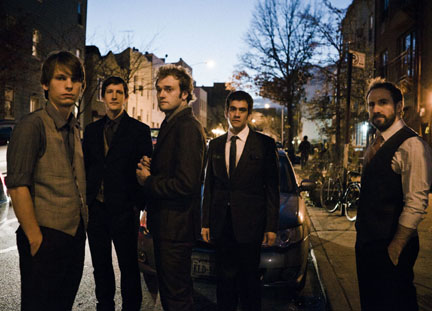
In a windowless rehearsal room in the Prospect Heights neighborhood of Brooklyn, N.Y. the Punch Brothers are exploring – to co-opt a Shakespearean phrase – “the undiscovered country.” While the famed bard was referring to death, for this quintet of top-notch bluegrass players, it means learning how to play live while utilizing audio effects on their instruments which they incorporated for the first time in the recording of their new album.
At the moment, fiddler Gabe Witcher is sitting cross-legged on the slightly elevated stage toying with various pieces of equipment arranged before him, namely an M9 Stompbox Modeler. Mandolinist Chris Thile, the group’s defacto leader, is standing above him, repeating the same few phrases over and over as Witcher punches buttons and dials the device’s six knobs up and down.
Most people wouldn’t notice a difference between the effects that Witcher’s proposing to the rest of the band who are standing in front of the stage giving feedback. However, to a once self-confessed acoustically “puritanical” band, using effects – however small and nuanced – is a very big deal. It’s an interesting dynamic watching world-class acoustic musicians fumble around with figuring out to how to corral various effects processors.
After 15 minutes, Witcher, Thile and the band’s sound engineer, Dave Sinko, appear to have finally keyed in on at least one of the tones that they’re after for Thile’s mandolin. “Might be a little too bright,” says Thile a moment after. “It’s not that it’s too bright; it’s that there’s not enough beef.” A few bars later later it sounds too “mid-rangy” to him.
After another spell of minute changes – with one misstep inspiring Thile to vamp on Weezer’s “Undone- Sweater Song” – it once again appears that the band has collectively found the tone they’re searching for. It proves mercurial.
“Whatever you just did killed most of the beef in the sound,” says banjoist Noam Pikelny to Witcher.
“It’s too bright, isn’t it?” says Thile again of the latest version.
“That kills it – you’re losing most of the body of the instrument,” responds Pikelny.
“That’s just the treble,” Witcher says looking up and appearing mildly perplexed.
“That sounds nasally,” retorts Pikelny of the next offering.
“What’s this do?” Witcher asks, tweaking a knob.
“Makes it clearer,” says Pikelny, whose eyes are closed in concentration.
After Thile plays a few more bars and Witcher finesses further, the fiddler asks for more feedback.
“Put the Tube Screamer back in,” says Pikelny in reference to a guitar overdrive pedal, later suggesting more gain on the M9 before rejoining guitarist Chris “Critter” Eldridge and bassist Paul Kowert at a table piled with stacks of coasters featuring individual portraits of each band member by New Yorker cartoonist Matt Diffee.
The first 2,500 pre-orders of the band’s new Who’s Feeling Young Now? album will receive a complete signed set. At the moment, the task seems almost Sisyphean to the group who’ve spent a majority of their down time over the last few days signing the coasters. (While this might not be the case, then it certainly feels that way to them.)
Thile and Witcher hop off the stage a short while later, seemingly content – for the moment, anyway – with the last round of effects decisions.
“It’s the first tech rehearsal we’ve had in five-and-half-years of playing,” confesses Pikelny with a mix of pride and embarrassment.
More to the point: Five-and-a-half years ago, the Punch Brothers didn’t exist.
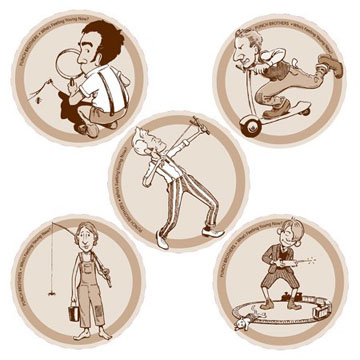
The coasters
Though the dynamic within the Punch Brothers is an affable democracy, it owes its existence to Chris Thile, who assembled the players for his fifth solo album, How to Grow a Woman from the Ground. And while all the musicians are some of the best in the business, Thile’s talent is at another level.
Growing up in Oceanside, Calif., Thile began playing mandolin at age five; by nine, he could play guitar and violin as well. After second grade, his parents began home-schooling him. His father, Scott, was a piano tuner by trade and the family began attending weekly bluegrass concerts at the local pizza parlor at the behest of a local piano teacher, whose son John Moore played mandolin in the band.
It was at these gigs – Thile family attendance became regular once Moore took Chris on as a pupil – that the young mandolinist met fellow music wunderkins Sean and Sarah Watkins who played guitar and violin, respectively, and sang. Thus, in 1989, Nickel Creek was born.
While playing in the band, Thile released his first album Leading Off on Sugar Hill Records – comprised largely of original material – at the age of 13. His next album, Stealing Second, came out three years later in 1997. (If you’re wondering about the baseball theme, Thile excelled at the sport as a kid and remains an avid Chicago Cubs fan.)
Nickel Creek, with the help of singer/songwriter Alison Krauss, signed to Sugar Hill, released their first record in 2000, and soon, their decade’s worth of hard-earned fans grew substantially. Two years later, they won a Grammy for their sophomore effort This Side. ( “It’s quite possibly our weakest record, creatively speaking,” acknowledges Thile.)
In 2001, at the age of 17, the International Bluegrass Music Association named Thile the mandolin player of the year. It was around this time that he enrolled at Murray State College in Kentucky – Thile had been home-schooled since third grade and grew up without television – though he dropped out after three semesters to pursue music full-time. (He’s expressed little interest in returning to college for a degree.)
On the heels of their third record, Why Should the Fire Die? , released in 2005, Nickel Creek called it quits. “I’m quite proud of the third Nickel Creek record but the first two were very, very young and I think we sound it,” says Thile today. “For that third record, we were starting to get of the age where one could count on some better music coming out.”
The dissolution of Nickel Creek seems to have as much to do with mounting industry pressure and internal band dynamics as it does personal turmoil within its members – namely Thile.
Engaged in 2002 and married in 2003, Thile and Jesse Meighan divorced 18 months later in 2005. Throwing himself further into music, Thile released How to Grow a Woman from the Ground in 2006 and, during the press around the album, began candidly discussing the disillusionment that his divorce had caused while also questioning some of the foundations of his longtime Christian upbringing.
“In conservative Christianity, [my parents] found some rules that were black and white,” says Thile of how they used their faith as a guide to raising to their children. “In some areas, those rules were good and helpful; in some areas they weren’t so much. My parents were smart enough to continue to evaluate things and eventually they backed off a lot of things. They kept subjecting everything they were being told to reason.”
Whether it was the cover of The White Stripes’ “Dead Leaves and the Dirty Ground,” The Strokes’ “Heart in a Cage” (which included Thile singing the word “fuck” ) or the evocative title track written by Tom Brosseau on How to Grow a Woman, it seemed to some that these edgier songs of heartache found Thile a good distance away from where he’d found many of his original fans.
And for an artist championed by the Christian community – largely due to Nickel Creek, whose work openly celebrated the faith – some longtime followers were rather distraught.
“If his mindset were on things above, and not earthly things, the level to which his composition would reach would be absolutely amazing!” wrote one fan in December 2006 on an online Nickel Creek discussion board. “There would be so much more meaning behind everything instead of a girl or things like that. Girl-related songs aren’t bad but when that is the main focus of your song selection, then there’s a problem.”
Another in the same discussion felt that Thile would be “a happier guy if he knew more things about God. Not so freakin melancholy. Just pray for him.”
And still another who didn’t want to sound “over-obsessed with Chris” prayed for him every night with the hope that he “finds what he needs in life,” adding “I am so sorry for him and his divorce and for his questioning of religion. I just want him to settle it out and just keep playing that mandolin.”
Thile suggests that, “Expressing something verbally is always going to be a little bit of a caricature of what’s actually going on,” in regard to how fans might misconstrue his lyrics or comments to the press. As someone that describes themselves as displaying OCD-like qualities, that caricature can be a double-edged sword in its like lack of precision and clarity.
“Situations are never black and white,” he says of life’s big issues such as faith and love. “So when I write, there’s a lot of gray area. As a person, the grays in life infuriate me but as a musician, I celebrate that kind of thing. Expressing the gray areas in life through music helps me come to terms with some.”
Helping Thile express those ideas on How to a Grow Woman was a group of musicians that he likened to the band that Miles Davis assembled to cut Kind of Blue – a band that he put together to form a foundation to explore increasingly ambitious musical ideas.
After a tour in support of the album, the How to Grow a Band rechristened themselves the Punch Brothers. The name derives from a Mark Twain short story “Punch, Brothers, Punch!” published in 1876 under the original title “A Literary Nightmare,” which cautions against filling one’s self with frivolous entertainment.
While the Punch Brothers are entertaining, they are by no means frivolous.
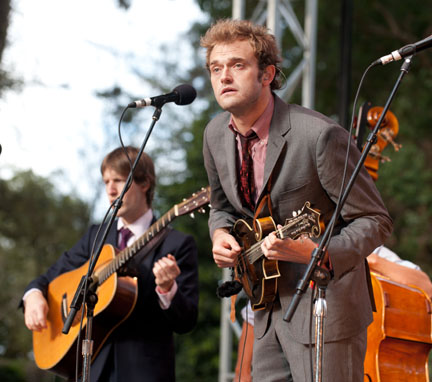
Photo by Dave Vann
All in their thirties, the Punch Brothers have a mix of new school and old school bluegrass. Banjoist Noam Pikelny played with New Grass Revival singer/bassist John Cowan and Leftover Salmon after the latter band decided to press forward after founding member Mark Vann died in 2002. Fiddler Gabe Witcher, who’s been friends with Thile since his Oceanside days, has collaborated with everyone from dobro master Jerry Douglas to alt-rock figurehead Beck. Guitarist Chris Eldridge was a member of The Infamous Stringdusters. Paul Kowert – who replaced original bassist Greg Garrison in 2008 – studied under Edgar Meyer at the Curtis Institute.
At the center of the Punch Brothers 2008 eight song debut, simply named Punch, is a four-part, 40-minute movement written by Thile called “The Blind Leaving the Blind,” which is based on moving past his divorce and his consequent social and religious meanderings. (A year earlier, the band debuted it at Carnegie Hall in New York.)
Musically, Thile describes “The Blind Leaving the Blind” as sounding between Nickel Creek and a mandolin concerto he wrote titled, “Ad astra per alas porci,” which translates to “to the stars on the wings of a pig.” With heavy classical influence from composers such as Brahms and Debussy, there are still little pockets to improvise in like in a traditional bluegrass tune. Its genre-melding and slippery classification was a harbinger of what was to come.
2010’s Antifogmatic benefited from the band’s extended time together on the road to the degree that they performed all of the material live before going into the studio. The music itself, while more melodically accessible than the previous record in many respects, remains highly technical and dense with little breathing room. While it’s fun, the songs still tend to shy away from typical song structure.
With the previous two records in mind, the band made a conscious decision not only to refine and simplify the music but also to, ideally, make the lyrical content and themes more accessible.
If the jubilant Antifogmatic is about the band’s collective acclimation to life in New York City – and the overtly complex Punch is ostensibly about Thile’s divorce and religious upheaval – then the more succinct and diverse Who’s Feeling Young Now? centers on coming to terms with being a responsible thirtysomething male in matters of the mind and body.
The slinky title track, for instance, is about the “impossibility of casual sex,” according to Thile, who is responsible for all the band’s lyrics but writes in them in a “very collaborative” fashion with band members. “It’s about that awkward period where you’re really not use to having to deal with the consequences of living.”
Witcher rephrases the sentiment: “That weird period where the stakes are higher and you haven’t settled that yet. You’re denying full force.”
(When asked if they intended there to be such a striking R&B flavor to the song, the band replies in the affirmative, noting that the inspiration was Justin Timberlake’s “Cry Me a River.” Additionally, Thile says that he realized, after the fact, that “Hundred Dollars” was influenced by the short-lived girl group Dream’s “He Loves Me, He Loves You Not.” )
The wobbly and woozy “Patchwork Girlfriend” is, in part, culled from the problem of having a significant other if you’re traveling all the time. It’s also about the time in between relationships where “you’re not seriously playing the field,” says Thile. “[In your head], you’re constructing a workable relationship out of many people.”
Elsewhere, the classic newgrass of “Clara” makes an appeal for in-person communication in the wake of the digital age of communication, while the old-timey “Soon or Never” is an archetypal (if oblique) tale of searching for one’s true love.
“Previous to this record, our music and our lyrics have been fairly personal and communal in an insular way,” confides Thile. “What I’m proud of about this record is that it marks a departure in the sense in that its something that is – quite sincerely – a call to community and musical fellowship.”
As Thile began writing material for the record, he also did so with greater studio production in mind than the band had previously used. “To continue to deny that side of the studio experience, it might have actually started to become insincere instead of being a hurdle to be proud to have jumped over,” he says.
Up until this point, the band had never used any – any – effects on their instruments. “We had an idea of wanting to use the studio as an instrument but didn’t have any idea of how to proceed beyond that general idea,” says Eldridge. After some amount of discussion, they decided to reach out to the Nashville-based producer Jacquire King.
While King’s recent production credits include Norah Jones, Kings of Leon and Cold War Kids, it was his work on Tom Waits’ Mule Variations, Alice and Blood Money that caught the band’s ear, particularly Thile’s. “As far as combination of reality and fantasy sounds, that’s the gold standard,” he says of the Waits’ albums.
Compared to how they cut Antifogmatic, Witcher says that the approach to Who’s Feeling Young Now? was the complete opposite: “The idea [on Antifogmatic ] was for [producer] Jon [Brion] was to capture the band in all its naturalness and showcase that. Which is what we did, why we setup the way we did and recorded it the way we did.”
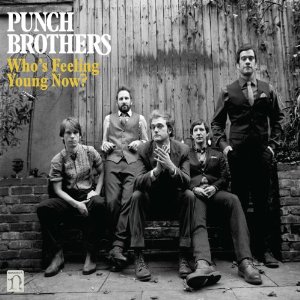
Part of King’s condition on working with the band was that he wanted be involved early on in the writing and creation process. “He didn’t want us to show up at the studio, meet us and make a record,” says Pikelny.
“Which is also what we wanted,” Thile quickly adds.
“It’s exactly what we wanted,” Pikelny says even more quickly.
King began visiting the band in New York at Thile’s apartment where they would play him whatever they had come up with – a complete song, a fragment or something that had yet to be arranged. The band made adjustments to melodies and arrangements based on some of King’s feedback.
“The trust was established very early and he provided something we hadn’t been able to figure out – and I don’t think we would have been able to figure out on our own,” says Pikelny of the band’s confidence in King. “The experimentation and the sculpting of all these sounds into soundscapes, we could have been in a studio for months by ourselves chasing our tails trying to figure out how to make this happen.”
Indeed, by all accounts, King was the keeper of Pandora’s box over the course of three weeks of recording at Nashville’s Blackbird Studios. Wanting to capture the live nature of the band while utilizing the studio’s effects capabilities, King dual mic’d all the instruments, running one of the signals into a selection of amps in isolated booths whose effects he could then endlessly tweak. The effects were then run back through headphones that all the band members would wear.
“The topics on the record are more urgent this time,” suggests Thile. “The lyrics are more integral to the process this time and I think actually hearing some of those effects in the ears lent unintentional intensity to the performances that we hadn’t had before.”
For each song, the band would begin playing while King ran back and forth trying different amps and effects to find a starting point. “We’d be sitting there playing with our headphones on and magically something would be shifting – and you had no idea whether he brought in a new pedal or he changed a setting or there was a new amp,” recalls Pikelny.
With all this discussion of studio wizardry, one might be expecting to hear an album of radical departure. Here’s the thing: By and large, you won’t notice any of the effects. When all five instruments are going, it sounds natural. Should you isolate any one instrument, you could likely tell that its inherent acoustic sound has been augmented by something unnatural. The holistic approach gives the overall sound more – to use Witcher’s no-pun-intended adjective – “punch.”
“The most interesting phenomenon was that as soon as all the effects got right, we started playing the song a lot better,” says the fiddler.
“It gave everything new life,” chimes in Thile regarding the effects. We all sit around and work on a song and play it 50 or 100 times trying to get it right, and all of a sudden, it’s a brand new toy. You approach with this new…"
“…sense of discovery,” says Elridge finishing Thile’s sentence.
“We’ve always wanted to be able to go into the studio and somehow capture some of the energy from a live show,” segues Pikelny seamlessly.
While the Punch Brothers cover an array of artists’ songs live, they’ve yet to record any of them on album under their name until now. Two covers made it on to the proper album – Radiohead’s “Kid A” and Väsen’s “Flippin” – both instrumentals. (The band recorded three more that didn’t make it – Gillian Welch’s “Down Along the Dixie Line,” Josh Ritter’s “Another New World” and McCluskey’s “Icarus Smicarus.” Four additional originals are on the vinyl edition.)
“We had many late night philosophical conversations about why does something seem to fit so perfectly in a live show – a cover, for example – but why have we shied away from it on a record,” says Pikelny. “There’s still a debate, right up until the last minute, of what fits.”
And what fits into the Punch Brothers’ burgeoning original catalog these days does not necessarily have the same profile that it did a few years ago. “We had to get to that place of playing the most complex and crazy [material where we were] utilizing every aspect of our brains while we’re maxing out our technical ability at all times,” says Witcher of the band’s changing approach. “We did that in order to be able to say, ‘We did that. We do that when we went to. [Now], let’s try and make good songs.’”
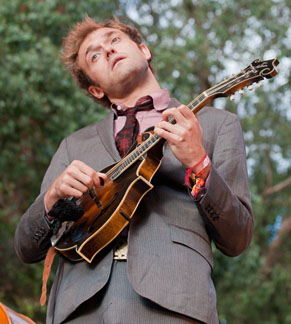
Photo by Dave Vann
Before they even released Who’s Feeling Young Now?, the quintet was already back in the studio. Now the go-to group for that string-based Americana sound, the quintet recorded in London with an orchestra for the soundtrack of the highly anticipated film The Hunger Games out this March, which T Bone Burnett is overseeing. Another project that Burnett brought them into the studio for is a forthcoming Coen brothers film Inside Llewyn Davis which stars Timberlake and Carey Mulligan. (Burnett was the force behind the soundtrack to O Brother, Where Art Thou? which reinvigorated the bluegrass and Americana genre.) Brion, who produced the band’s Anitfogmatic, also requested them in the studio recently to work on music for a new Judd Apatow film This is 40 featuring Paul Rudd, Megan Fox, Albert Brooks and John Lithgow, among others.
And while the Punch Brothers are Thile’s priority, he has even more projects in the wings. His individual tours with bassist Edgar Meyer and violinist Hilary Hahn are examples; so is his ongoing collaboration with cellist Yo Yo Ma alongside Meyer and fiddler Stuart Duncan. (The quartet plans to tour behind their recently released album, The Goat Rodeo Sessions at some point.)
Another is a proper duo tour of the States with jazz pianist Brad Mehldau in 2013. The two dipped their proverbial toes in the water last year with a few concerts in the U.K., which saw them tackling one another’s compositions along with covers such as Bob Dylan’s “Don’t Think Twice It’s All Right,” Elliot Smith’s “Tomorrow Tomorrow” and Radiohead’s “Knives Out.”
And still another is something that Thile describes as a “concerto/song cycle” that he wrote for himself, guitarist Julian Lage, vocalist Aoife O’Donovan and orchestra. “It won’t come out for a long time,” he assures. “And I’m continuing to get the solo Bach to a place where I feel good about recording it.”
One project that Thile is not pursuing any time soon is Nickel Creek. Though fans were treated to a surprise set last October at Los Angeles’ Largo when he joined Sarah and Sean Watkins for their monthly residency at the venue – and subsequent rumors of a festival-based reunion quietly spread – Thile assuredly says that nothing of the sort is happening. If anything, he’s worked hard to respectfully distance himself from being defined by the group.
“It’s difficult for people to understand how regressive it feels, personally, to be…” He pauses as he carefully chooses his words.
“To be related…” He pauses again searching for a more precise articulation and resumes.
“To be predominantly identified with something that you did a long, long time ago. I’m 30 years old now, and if you have one Nickel Creek record, the one that you have has material on it that we developed when I was 15 years old. I’m not itching to go back there.”



















